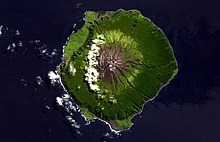Queen Mary's Peak
| Queen Mary's Peak | ||
|---|---|---|
|
Queen Mary's Peak (center) |
||
| height | 2060 m | |
| location | Tristan da Cunha | |
| Coordinates | 37 ° 6 ′ 40 ″ S , 12 ° 17 ′ 18 ″ W | |
|
|
||
| Type | Cinder cone | |
| Age of the rock | 148 ± 8 ka | |
| Last eruption | 1961–1962 | |
| First ascent | around January 1, 1817 | |
| particularities | highest point in the South Atlantic | |
The Queen Mary's Peak on the island of Tristan da Cunha is with a height of 2060 meters the highest elevation in the South Atlantic . The mountain was named after Mary of Teck , the consort of George V . It was first climbed around January 1, 1817.
Queen Mary's Peak is a cinder cone and forms - with others - the summit of the massive, active shield volcano , which makes up the entire island. In the summit region there is a 300 meter wide crater in which there is a heart-shaped crater lake . In winter this lake is mostly frozen and the uppermost, vegetation-free slopes of the volcano are covered with snow. Its age is estimated at 148 ± 8 ka .
An eruption around 1700 is known from geological studies, which occurred on the south side of the volcano. In October 1961 there was an eruption on the north side, which resulted in the temporary evacuation of all residents of the island to Calshot in England .
The mountain was used in earlier times by sailors on their route between the Indian Ocean and Europe as a navigation aid. In the 17th century the East India Company commissioned all captains to sail via Tristan da Cunha.
Web links
- Queen Mary's Peak in Global Volcanism Program of the Smithsonian Institution (English)
- Description of Queen Mary's Peak on the official website of Tristan da Cunha
Individual evidence
- ^ Dugald Carmichael: Some Account of the Island of Tristan da Cunha and of its Natural Productions. The Transactions of the Linnean Society of London, 1817, Vol. 12, pp. 483-513.
- ^ Volcanic Hazard Assessment of Tristan da Cunha, South Atlantic. Peter Dunkley, British Geological Survey, 2002.
- ^ Tristan da Cunha in the Global Volcanism Program (accessed December 8, 2012)


